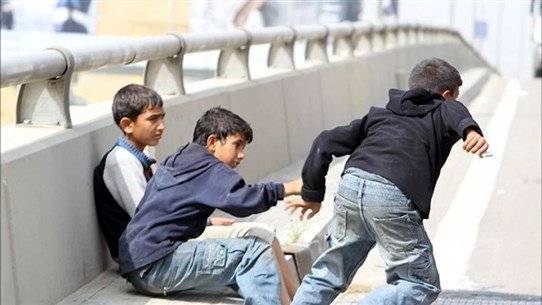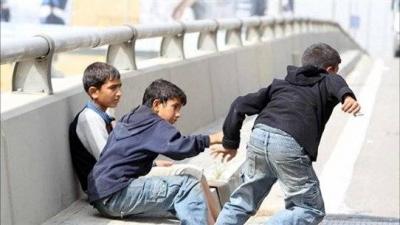Crime is not merely an individual choice. Economic, social, and political conditions have a profound impact on people's behavior and their motivations to engage in actions that are criminalized by law. It is true that the rate of certain crimes in Lebanon is increasing in areas that lack state attention, where residents suffer from unemployment and poverty. However, the collapse of the national currency's value and the worsening of the living crisis are continuously increasing crime levels throughout Lebanon since 2019. The most concerning aspect is the deprivation of many teenagers from school and education due to their parents being unable to cover its costs and the resort of many poor families to child labor. We will strive to explain some of the increasing criminal activities among adolescents according to criminology and some elements of street crime environment.
At a corner of the Sidon market, Abu Fadi (46 years old) sits in front of a vegetable cart. His two children - the eldest is 13 years old - call out to attract customers. They look as if they haven't had a full meal in days. Abu Fadi says he hasn't sent them to school for two years, and he has no ability to enroll them this year either. He affirms that he tried, but "there is nothing we can do. The situation is miserable; who has the energy to think about schools? The backpack costs 400,000 liras, a coloring box is 100,000. The bus fare is a million for one child; I only have this cart, how can I take them and bring them back? Let them stay with me on the street, they learn a trade and find outside work; what can I do?"
Poverty and deprivation are essential factors in adolescent delinquency and their inclination to commit crimes. Their lack of basic needs and healthy developmental growth places them in a state of stress and tension, constantly feeling frustrated due to the lack of financial resources, which are the only means to meet their needs and desires through legal channels. This makes them more inclined to commit crimes compared to youths from affluent families who easily access whatever they desire through legitimate means.
However, there is no single theoretical perspective that can sufficiently explain the multiple variables and factors that cause criminal behavior in adolescents and teenagers. Therefore, criminologists have drawn from various social theories and combined them to explain crime and deviance. Before delving into the details of these theories, it may be better to present the social factors contributing to criminal behavior.
### Social and Economic Motivations
Criminological literature identifies a set of environmental factors as related to the criminal behavior of adolescents and teenagers. These include developmental, social, and economic factors.
In light of the economic problems and financial distress that most of Lebanon's population suffers from, there has recently been a significant surge in the number of homeless children, teenagers, vendors, and beggars in the streets and markets, lacking schools and even the most basic rights. It is no longer limited to the children of displaced persons or refugees or residents of certain poor areas; the streets of Beirut today are crowded with many school students who have been deprived of their education. We observed some of them gazing sadly at children of their age who move around with their families in luxury cars going to private schools.
Additionally, family disintegration and violence that some children face within families due to the stress caused by deprivation lead to the exploitation of children and teenagers in organized begging networks, which have increased since the onset of the severe living crisis. Malnutrition associated with poverty is also a particularly concerning aspect that affects children's developmental growth. Nutritional deficiencies may lead to problems such as cognitive difficulties, poor emotional control, or its exacerbation. Such cognitive impairments and brain function disorders have been identified as precursors to delinquency in some youths.
### Non-Conformist Deviance
Some youths deviate because they lack the means and ways to satisfy themselves and meet their needs. Given their limited outlook, they often find their goals unattainable and feel helpless; thus, they resort to illegal means to achieve their aims. For example, a youth dreaming of buying sneakers but lacking the sufficient money to do so and unable to earn it through begging may decide to obtain the shoes through means that violate the behavioral standard supposed to be learned at home and in school. Consequently, they might resort to borrowing, stealing, selling items that do not belong to them, or deciding to join a theft gang or sell drugs, among other criminal acts. Criminologists refer to this phenomenon as "non-conformist deviance." The American researcher Robert Merton developed this concept in the 1940s to search for suitable remedies. Merton explained that the wider the gap between means and goals, the higher the rates of non-conformist deviance.
### The Impact of Subculture
As soon as the traffic light turns red, a five-year-old girl named "Lulu," wearing an oil-stained sweater and torn shorts, shouts out, proudly claiming to be the "only educated" one among her older peers due to her knowledge of some Arabic letters: "Red, come on!" A group of children and teens rushes toward the stopped cars. One sprays soap on a car window, while another begs the owner of a Mercedes, saying, "God bless your sweet face," as if executing a previously agreed-upon plan and tricks they have devised and trained to carry out.
It becomes evident that some habits, customs, arts, and practices form among certain youth and adolescents in the streets. They may devise specific words and gestures that may not be understood by those outside the subculture they belong to. The subculture becomes a primary guiding factor for the behaviors of youths and adolescents, defining shared behaviors and "rules" for practicing these behaviors among themselves and with others. The subculture determines the sharing of sidewalks and streets for beggars and flower sellers, for instance, and familiarizes them with methods of pickpocketing, fraud, and theft while teaching them expressions and terms they may not understand the true meaning of due to their young age.
Society, of course, views the subculture of street children as contrary to societal values and not in line with mainstream culture, thus crystallizing it as a deviant subculture. Sociologist Walter Miller was one of those who analyzed the integral structure of the deviant subculture and showed that deviance is an inseparable part of it.
### "I Miss School So Much"
Rahab (14 years old), dressed in neat clothes and with her tied blonde hair, attends daily at a spot a little beyond the traffic light near a mall in Sidon, from eight in the morning until dusk. She is the eldest daughter in a family of five children, with a sick Lebanese father who is bedridden, and a Syrian mother who watches over her from a distance as a guard to prevent anyone from approaching her. Rahab left school two years ago.
Unlike her peers near the traffic light, she seems less prone to exploitation. She knows her strengths well and exploits them to elicit sympathy from the owners of the stopped cars. She says with a tone of regret: "I miss school so much, but what can I do? Rent, subscriptions, and my younger siblings; I won’t let my mother extend her hand… I am blessed, by God, with height, beauty, and neatness, and I plead for help with refinement, and thank God, it works out." When asked if she faces harassment, she replies: "Those who do bad things come early in the morning and leave in their cars. I have nothing to do with everything here, and thank God no one dares to approach me." But how long can Rahab withstand the non-conformist deviance? Will she remain steadfast against complete deviancy if the economic crisis worsens or her family needs more money? Can she stay away from the subculture, or will she gradually succumb to it as happened with other street children and teenagers?
### “We’ve Trained Them…”
Although Article 618 of the Lebanese Penal Code states that "whoever leads a minor under the age of eighteen to beg for personal benefit shall be punished by imprisonment for a period of six months to two years," the problem is not resolved by simply arresting the beggars and those who employ them. This is confirmed by one of the adolescent beggars (15 years old), who refused to disclose his name: "The police pick us up and let us go; we got used to it, but now they are leaving us alone, see them..." pointing to two officers standing to manage the traffic at the light, and he adds: "We’ve trained them; from seven in the morning until one at night, we are here and they don’t approach us."




